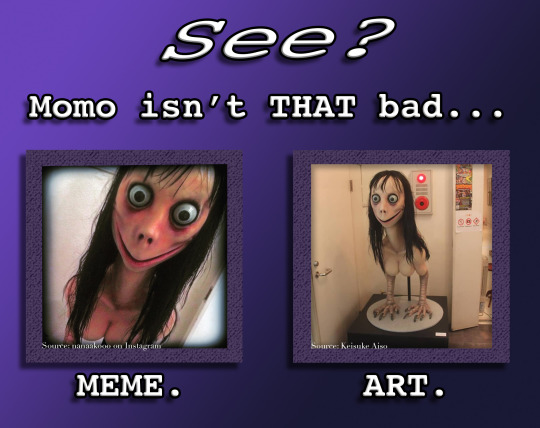Text
That Measly Momo

The Momo Challenge has infiltrated children’s lives when users on YouTube Kids added photos of “Momo,” a creepy Japanese horror sculpture, into children’s videos, and how to contact her on WhatsApp, a texting application. The challenge involves texting Momo on WhatsApp, and performing various challenges that she gives to you, or else she will “get” you. The challenges the character gives start off as harmless, but can become more violent and harmful as challengers progress, being asked to do things such as perform self-harm, and even commit suicide.
The issue, however, is that there is no true imminent threat. Many stories suggested that some children have taken their lives specifically from the Momo challenge, yet they lack a credible source confirming the news (Dickson, 2019.) Momo seems to be used more to incite terror among both children and parents, and trying to infiltrate lives as much as possible. So although Momo poses no true threat to people, she still is causing issues regarding children’s sense of security and well-being.
If curious children who learned about Momo wanted to contact her, they would have to use the popular application, WhatsApp. WhatsApp is a third party messaging application that can be used across platforms and around the world. Therefore, anyone who downloads the application has the opportunity to contact the mysterious Momo. Parents seeing WhatsApp as a harmless texting app can lead them to overlook the possible danger of the ability to contacting strangers thinking it is Momo. And when contacted by Momo, kids are informed that they must perform tasks or else their personal information would be leaked, or they would be violently threatened (Dickson, 2019).
Although they are false threats, these are real fears children living in the digital age may believe. Contacting Momo may ruin a child’s mental health, and cause them to lose a sense of security, all because they texted a WhatsApp number. But recently, trolls have been getting children acquainted against their will to Momo, by bringing her presence onto other media platforms that censors child-inappropriate content.
YouTube created YouTube Kids in 2015, a version of their platform that only plays approved, child-safe uploads. Lately, trolls on YouTube have found a way to surpass YouTube’s strict filtering for their children-centered platform. By editing Momo into what seems to be a clip of normal children videos, like Peppa Pig and Baby Shark, they are able to infiltrate and scare children (Herrman, 2019). This, however, was brought into the spotlight by parents whose scared children came to them, causing a wildfire of fearful parents storming the Internet for answers, like who is Momo, and what else has Momo done. But there was not much to fear, considering many horror stories about Momo were made up, or from unreliable sources (Herrman, 2019).
Momo brought a lot of horror, and annoyance, so far in 2019. Overnight, it seemed as though Momo gained fame and success from every terrified child and nervous parent. Momo is not real, she is just a horror statue made in Japan, she cannot physically do anything to you. And the person on WhatsApp? Just a troll, claiming to be her. What happens to children on the Internet can affect them both negatively and positive, so make sure they know not to contact strangers, and remember… Momo is not real.
Reference
Dickson, E. (2019, March 01). What Is the Momo Challenge? Retrieved from
https://www.rollingstone.com/culture/culture-news/what-is-momo-challenge-800470/
Herrman, J. (2019, March 02). Momo Is as Real as We've Made Her. Retrieved from
https://www.nytimes.com/2019/03/02/style/momo-mania-hoax.html
3 notes
·
View notes